New to Asian cooking? This is your starter list. I share what to buy first, how to use it, and how to store it so it lasts. Stocking just a few essentials will give you everything you need to start cooking your favorite Asian dishes with confidence.
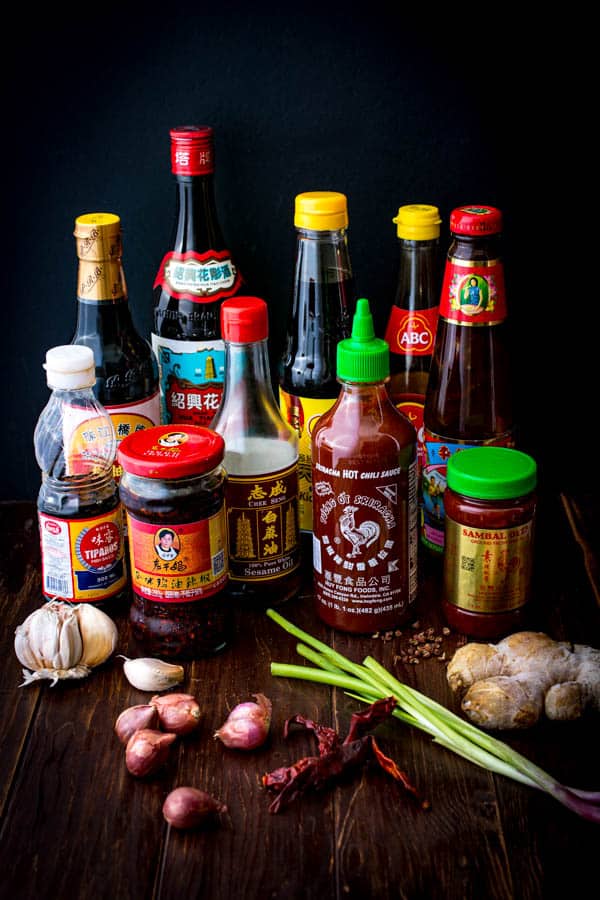
If you’re looking to expand your Asian cooking repertoire, it helps to keep a few staples on hand. With the right sauces, spices, and pantry basics, you’ll always be ready to satisfy whatever takeout craving hits.
These are the core pantry staples used across most Asian recipes (and in many of my recipes here, too). Most of them are easily available at your local supermarket, and if not, your nearest Asian grocery store (or online) will likely have what you need. I even have a guide to shopping at an Asian grocery store if you’d like some tips.
No need to buy everything at once. Start simple with just soy sauce, Shaoxing wine, sesame oil, oyster sauce, and cornstarch. As you try more new recipes, you can gradually build up your pantry from there.
And if you’d like to make sure your kitchen is set up for success, be sure to check out my top 10 Asian kitchen tools, and browse my collection of Asian recipes.
Table of contents
SAUCES
Soy Sauce

What it is: A salty, umami-rich seasoning made from fermented soybeans, wheat, water, and salt. It’s the backbone of many Asian sauces and is used for seasoning, marinades, and dipping sauces.
How to use it: Light soy sauce is the default when a recipe simply calls for “soy sauce.” Use this to season stir-fries, fried rice, noodle dishes, and for dipping sauces.
Storage tips: Soy sauce can be stored at room temperature. I keep my soy sauce in a squeeze bottle so it’s easier to drizzle straight into the wok for my stir-fries.
Substitutions:
- Tamari for gluten-free cooking
- Liquid Aminos for a gluten-free, soy-based alternative.
- Coconut Aminos for a gluten-free and soy-free option, slightly sweeter and less salty.
- Maggi Seasoning (really good with fried eggs!)
Brand tip: I recommend Pearl River Bridge Light Soy Sauce for Chinese-style cooking and Kikkoman as a versatile Japanese option. Because soy sauce is such a key ingredient in any recipe, it is a good idea to find and stick with a brand that you love.
Recipes to try:
Dark Soy Sauce

What it is: A thicker, darker soy sauce with a touch of sweetness (usually from molasses). It adds deep color and a richer flavor. It is not a concentrated version of light/regular soy sauce, so it should not be diluted to replace it.
How to use it: Use just a touch to deepen the color and add a subtle caramel note to stir-fries, braises, and sauces. Most recipes use light soy for saltiness and a small splash of dark soy for color and depth of flavor.
Storage tips: Keeps well at room temperature in a cool, dark pantry. I transfer mine into a squeeze bottle, too. Since it’s thicker, it’s less messy to pour this way.
Substitutions:
- Light soy sauce plus a small amount of molasses or dark brown sugar to mimic the color and mild sweetness
- For gluten-free: tamari plus a touch of molasses
- Kecap manis is sweeter and thicker. Use this only if the recipe suits a sweeter profile.
Brand tip: I like Pearl River Bridge Dark Soy Sauce
Recipes to try:
Sesame Oil

What it is: A fragrant oil pressed from toasted sesame seeds, especially popular in Korean cooking. It has a strong, nutty aroma and flavor, so a little goes a long way.
How to use it: Best used in marinades, sauces, dressings, or drizzled as a finishing touch to soups, noodles, or stir-fries. Avoid deep-frying because of its low smoke point.
Storage tips: Sesame oil can be stored at room temperature in a cool, dark spot, but it can go rancid more quickly than other oils. To extend the shelf life, refrigerate after opening.
Substitutions:
- Peanut oil can add a touch of nuttiness, but it won’t have the same toasty aroma as sesame oil.
Brand tip: Kadoya is a reliable brand often found in most grocery stores.
Recipes to try:
- Korean Japchae
- Easy Korean Beef Bowl
- Stir-Fried Ginger Sesame Chicken with Bok Choy
- Want more ideas? Check out my post on recipes with Sesame Oil
Shaoxing Wine

What it is: A traditional Chinese rice wine made from fermented glutinous rice. It adds aroma and complexity to sauces, marinades, and stir-fries. While high-quality Shaoxing wine can be enjoyed as a drink, the bottles sold in the sauce aisle of most Asian grocery stores are intended for cooking only.
How to use it: A splash of Shaoxing wine brings balance to savory dishes and adds that restaurant-style touch to stir-fries and braises.
Storage tips: Store at room temperature in a cool, dark place.
Substitutions:
- Dry sherry is the closest match in both flavor and function.
- Mirin (Japanese sweet rice wine) can work in a pinch, but it is sweeter, so reduce sugar in the recipe.
Brand tip: Look for Shaoxing Hua Diao wine. Avoid Shaoxing cooking wine that lists salt as the first ingredient, if possible, as it can be a bit too salty.
Recipes to try:
Fish Sauce

What it is: A staple in Southeast Asian cooking, made by fermenting anchovies, krill, or other seafood such as crab and shrimp. It has a strong, pungent aroma but delivers a salty, savory depth of flavor that defines many Thai and Vietnamese dishes.
How to use it: Fish sauce is very rarely used on its own. It is usually mixed with sugar, lime juice, chilies, or vinegar to create dipping sauces, marinades, or stir-fry bases. It has a very strong aroma, so a little goes a long way!
Storage tips: Store in a cool, dark pantry at room temperature.
Substitutions:
- Equal parts soy sauce, vinegar, and oyster sauce
- There are also vegan fish sauces available, made with soy
Brand tip: Red Boat Fish Sauce and Tiparos are both great brands
Recipes to try:
Oyster Sauce

What it is: A thick, dark sauce made with oyster extract, sugar, and seasonings. It’s salty, slightly sweet, and packed with umami, adding depth and balance to many Asian dishes.
How to use it: Use it in marinades, dipping sauces, stir-fried noodles, or drizzle it directly over blanched or stir-fried vegetables for an instant flavor boost.
Storage tips: Once opened, store in the fridge
Substitutions:
- Vegetarian “oyster” sauce made with mushrooms is a great plant-based alternative
- In a pinch, combine soy sauce with a little sugar to mimic the salty-sweet profile (although it won’t have the same depth)
Brand tip: I recommend Lee Kum Kee Oyster Sauce. It is widely available and my go-to brand.
Recipes to try:
Rice Vinegar / Rice Wine Vinegar

What it is: A vinegar made from fermented rice. It has a mild, slightly sweet flavor that’s not as sharp than white distilled vinegar, which makes it perfect for Asian cooking.
How to use it: Rice vinegar adds brightness and tang to sweet-and-sour sauces, salad dressings, dipping sauces, and pickling brines. It’s essential in dishes like Thai cucumber salad or even sushi rice.
Storage tips: Store in a cool, dark pantry at room temperature.
Substitutions:
- Apple cider vinegar is a good substitute, though slightly stronger. Use a bit less.
- White wine vinegar or distilled white vinegar also works, but add a bit of sugar to mimic the sweetness.
Brand tip: Marukan and Kikkoman are my go-to brands
Recipes to try:
Sriracha Hot Chili Sauce

What it is: A popular spicy sauce made with chili, garlic, sugar, salt, and vinegar. It has a balanced heat with a touch of sweetness, making it one of the most versatile condiments in Asian cuisine.
How to use it: Use it as a dipping sauce, drizzle it over noodles or rice bowls, stir it into marinades, or mix it with mayo for a quick spicy spread.
Storage tips: Sriracha can be stored in the fridge or at room temperature.
Substitutions:
- Sambal oelek
- Gochujang
- Ketchup mixed with hot sauce
Brand tip: Huy Fong Foods is the most famous (nicknamed “rooster sauce” for the bottle design) but there are so many awesome brands to try!
Recipes to try:
- Rice Cooker Hainanese Chicken Rice
- Spicy Teriyaki Burger with Grilled Pineapple
- Penang Char Kway Teow (Malaysian Fried Flat Rice Noodles)
Would you like to save this?
Hoisin Sauce

What it is: A thick, dark reddish-brown sauce made from fermented soybeans, garlic, sugar, five-spice powder, and other seasonings. It has a sweet-salty balance with a hint of spice and is sometimes referred to as “Chinese barbecue sauce.”
How to use it: It is famously served as a dipping sauce for Peking Duck and Moo Shu Pork. It’s also used in marinades, stir-fry sauces, and as a glaze for roasted or grilled meats.
Storage tips: Once opened, store hoisin sauce in the refrigerator
Substitutions:
- Plum sauce (sweeter, fruitier, and less salty).
- Soy sauce mixed with a little sugar and five-spice powder
Brand tip: Lee Kum Kee is one of the most popular and reliable brands
Recipes to try:
SPICES
Chinese Five-Spice Powder

What it is: A fragrant spice blend traditionally made with cinnamon, star anise, fennel, cloves, and Szechuan peppercorns. The exact mix varies by brand, but it always delivers a warm, complex aroma that’s both sweet and savory.
How to use it: Use as a dry rub for roasted or grilled meats, or stir it into sauces and marinades. It’s the signature seasoning behind Chinese BBQ pork (char siu).
Recipes to try:
Cornstarch

Cornstarch, sometimes referred to as corn flour, is a pantry staple in Chinese and many other Asian kitchens due to its versatility.
A cornstarch-and-water slurry is the go-to method for thickening sauces, gravies, and soups.
It’s also essential in the “velveting” process in Chinese cooking, where meat is marinated with cornstarch (sometimes along with liquids like soy sauce and a splash of oil). This helps to seal in moisture so the meat stays tender even after the high-heat of stir-frying.
For deep-frying, cornstarch can be used to coat foods on its own or combined with all-purpose flour. It creates a lighter crust or batter compared to flour alone.
Substitution: Potato starch or tapioca starch can be used, though the results may vary slightly in texture.
Pro tip: Mix cornstarch with cold water before adding it to hot dishes to prevent clumping. I usually do this with my fingers instead of a spoon. It breaks up the lumps much more easily. The liquid must come to a boil in order for it to thicken with the cornstarch.
Ground White Pepper

White pepper is a bit spicier than black pepper but has a milder, less complex flavor. That subtlety allows the main ingredients in a dish to shine through without being overshadowed by the pepper itself.
Both black and white pepper come from the same plant, but they’re processed differently. Black pepper is made from dried, unripe berries, while white pepper is made from fully ripened berries that are soaked in water, then stripped of their skins before drying.
In Chinese and many other Asian cuisines, white pepper is preferred over black pepper for its gentle flavor and lighter color, which blends seamlessly into soups, sauces, and stir-fries without leaving dark flecks.
You’ll often find it sprinkled over hot and sour soup, congee, or simple stir-fried greens.
DRIED FOODS
Rice

Rice is the cornerstone of Asian cuisine. Unless it’s a noodle-based dish, most Asian meals are served with rice. It’s the foundation that balances flavors, sauces, and textures.
The most common variety you’ll find in Asian households is jasmine rice. With its light, fluffy texture and naturally fragrant aroma, jasmine rice pairs perfectly with everything from stir-fries to curries. It’s also my personal favorite. Versatile, easy to cook, and always comforting.
The texture changes depending on the grain length. Short-grain rice is higher in starch and turns sticky when cooked, which is why it’s the best choice for sushi and Japanese rice bowls. Medium to long-grain rice, like jasmine, cooks up fluffy and distinct.
Another variety to note is glutinous rice (sometimes called sticky rice or sweet rice). Despite the name, it contains no gluten. “Glutinous” simply refers to its sticky quality. It looks very similar to regular white rice when uncooked, so always double-check the label before buying.
Glutinous rice is too sticky for everyday meals but is meant for desserts and special dishes, like Thai mango sticky rice or Chinese zongzi (sticky rice dumplings).
Don’t have a rice cooker? No problem; I’ve got you covered with my step-by-step guide on how to cook rice without a rice cooker.
Dried Noodles
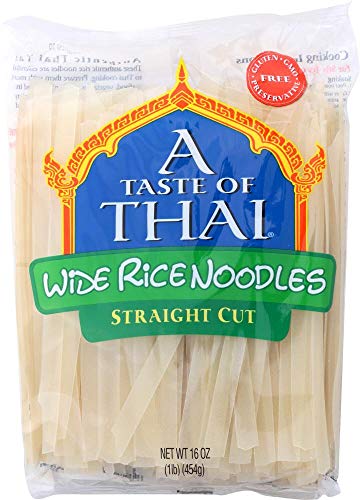
Dried noodles are a fantastic pantry staple because they last a long time and can be turned into countless dishes, from comforting noodle soups to quick stir-fries. They’re also inexpensive, making them an easy way to stretch your dollar.
Most supermarkets carry a good variety of dried noodles: rice noodles, egg noodles, buckwheat noodles, brown rice noodles, and more. Step into an Asian supermarket, and you’ll often find entire aisles dedicated to noodles in every size and thickness you can imagine.
Rice noodles and egg noodles are among the most common and versatile. Rice noodles are naturally gluten-free and come in many shapes, from thin vermicelli (perfect for soups and spring rolls) to wide, flat noodles (great for stir-fries like Pad See Ew or Char Kway Teow).
Egg noodles, with their rich yellow color and chewy texture, are the backbone of many Chinese stir-fries and soups.
Unlike fresh noodles, which need to be kept refrigerated and used quickly, dried noodles are shelf-stable and ready whenever you need them, making them the better choice for stocking an Asian pantry.
Dried Red Chili

If you love spicy food, dried red chilies are a must-have for your pantry. They add bold heat and depth of flavor to dishes and can be used in several ways.
Whole dried chilies are often stir-fried briefly in hot oil to release their aroma. You’ll see this in dishes like Kung Pao Chicken. They can also be broken into pieces to add spice to soups, broths, or stir-fries.
For sauces and curry pastes, dried chilies are typically soaked in warm water until they are softened, then blended into a smooth paste.
The heat level can somewhat be adjusted. Removing the seeds before cooking will reduce the spice, while leaving them in keeps the chilies fiery hot.
When handling dried chilies, especially if cutting them, it’s a good idea to wear gloves. The oils can cling to your skin and cause painful surprises if you rub your eyes. If you don’t have gloves, wash your hands thoroughly with soap after handling them.
Pro tip: I usually soak dried chilies in warm water for a few minutes, but if I’m in a hurry, I use hot water. It softens them within minutes.
Dried Shiitake Mushrooms
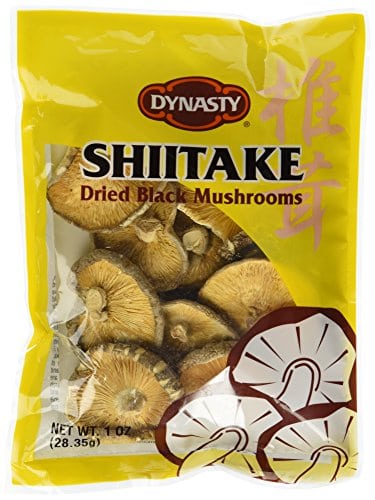
Dried shiitake mushrooms bring a deep, savory flavor that’s even more concentrated than fresh shiitakes. This makes them a key ingredient in soups, broths, and stir-fries, where just a few mushrooms can transform the entire dish.
To use them, just soak the mushrooms in warm or boiling water until softened. The soaking liquid becomes a flavorful broth that can be used as a base for soups, sauces, or braises.
Their versatility and long shelf life make dried shiitake mushrooms indispensable in Asian kitchens. They are used in traditional recipes like Japanese miso soup, ramen, and hot pots.
D ried shiitakes can also be ground into a fine powder. This works as a natural flavor enhancer and even makes a great vegan substitute for chicken bouillon powder.
FRESH INGREDIENTS
Scallions
Scallions (also known as green onions or spring onions) are one of the most common fresh ingredients in Asian cooking. They’re incredibly versatile, sometimes added early in a recipe to build flavor, other times sprinkled on at the very end as a garnish.
Freshly chopped scallions bring a pop of color and a delicate onion flavor to brightens up soups, stir-fries, noodle dishes, and rice bowls. Unlike regular onions, their flavor is mild and subtle, which means they enhance a dish without overpowering it.
Both the white and green parts are edible and serve different purposes. The white bottoms are more pungent and are often cooked with aromatics like garlic and ginger, while the green tops are milder and usually scattered over dishes just before serving.
Storage tip: I store scallions in the fridge in a cup of water with a plastic bag loosely covering the tops. They stay fresh and crisp much longer this way. Change the water in the cup every 3 days or so.
Ginger
Ginger is a must-have in Asian cooking. It’s sharp and spicy when raw, but once it’s cooked, it softens into a warm, fragrant flavor that instantly makes a dish smell amazing.
Peeling ginger is easy. I just scrape the skin off with the edge of a spoon. From there, it can be minced, sliced, grated, or cut into thin matchsticks depending on how it’s used.
For stir-fries, ginger is usually minced or cut into thin matchsticks and tossed into hot oil with garlic to infuse the base of the dish. In soups and braised dishes, thicker slices are added to slowly release flavor, then removed before serving.
Its versatility makes ginger a staple not just in savory cooking, but also in teas, marinades, and even desserts.
Storage tip: Keep ginger in the fridge in a small container or a ziplock bag lined with a paper towel. It helps to absorb the extra moisture and keeps the ginger fresh for a couple of weeks. For longer-term storage, you can freeze whole peeled knobs of ginger, then grate them straight from frozen when you need some (no thawing needed)
Garlic
Garlic is one of the most essential ingredients in Asian cooking (and honestly, in just about every cuisine). It adds instant depth and flavor to any savory dish, from quick stir-fries to long-simmered soups and braises.
In Chinese cooking, garlic is often minced and added to hot oil at the very start of stir-frying. This step infuses the oil with garlicky aroma, creating the flavorful base that the rest of the ingredients build on.
Garlic also plays a starring role in what’s affectionately known as the “Trinity of Chinese Cooking”: garlic, scallions, and ginger. These three aromatics are used so often that they form the backbone of many dishes.
Pro tip: It’s not always necessary to start with garlic for your stir-fries. If you tend to burn it, try adding it partway through stir-frying instead. You’ll still get plenty of flavor without the risk of bitterness.
Storage tip: Keep whole garlic bulbs in a cool, dark, well-ventilated spot (like a basket in the pantry).
Shallots
Shallots are a type of onion, but smaller, milder, and a little sweeter in flavor. They’re used widely in Asian cooking, both as an ingredient and as a garnish.
Shallots used in Asian recipes are much smaller than the larger variety often found in Western or French cooking. If a recipe calls for shallots and you’re using the larger kind, be sure to reduce the amount so you don’t overpower the dish.
One of the most popular ways shallots are prepared in Asia is by slicing them very thin and deep-frying them until golden brown. These crispy fried shallots are sprinkled over rice, noodles, soups, and salads for a savory crunch that instantly elevates the dish.
Storage tip: Keep whole shallots in a cool, dry, well-ventilated spot (similar to onions and garlic). Fried shallots should be stored in an airtight container once completely cooled.
Frequently Asked Questions About the Asian Pantry
Feeling a little overwhelmed by all the ingredients above? Don’t worry! You don’t need to stock your entire pantry in one go. Here are some of the most common questions I get about building an Asian pantry, along with simple answers to help you get started.
Not at all. Start with just a few essentials that appear frequently: light soy sauce, dark soy sauce, oyster sauce, sesame oil, Shaoxing wine, and cornstarch. Add more as you try new recipes.
Asian supermarkets have the widest selection, but you don’t need to go out of your way. Many regular grocery stores stock staples like soy sauce, rice vinegar, and sesame oil in the international aisle.
Online retailers also make it easy to find harder-to-find items.
If you’re new, here’s my guide on how to shop at an Asian grocery store.
Not usually. The differences are subtle, and unless you’re chasing a very specific traditional and truly authentic flavor, a good-quality soy sauce you like will work across most recipes.
Dried noodles, chilies, and mushrooms can last for months (sometimes years) if stored in a cool, dry place in airtight containers. Always check for signs of moisture or mold before using.

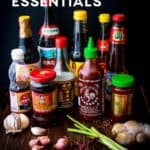

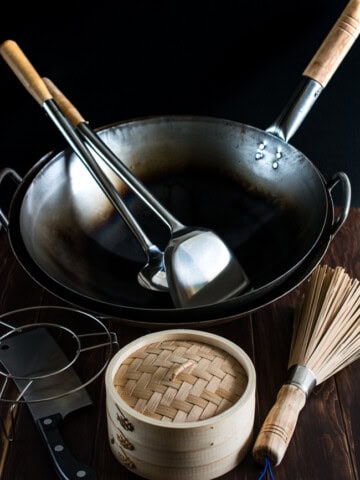
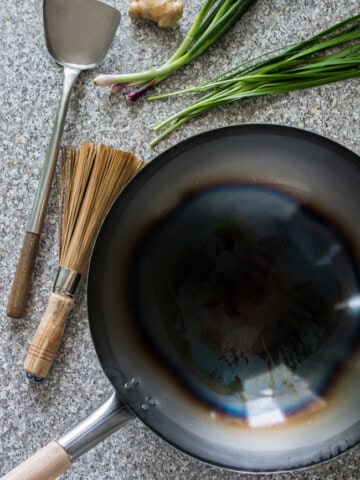
Donna says
Thanks for a great blog.
Char says
Thank YOU for your support, Donna!! 🙂
Suzanne says
This is an awesome list! Thank you!
Char says
You're very welcome, Suzanne! I hope you find it helpful. Take care!
Lenny Wollitz says
I live in Mazatlan, Mexcico. I have all of your pantry essentials on hand at all times except Shaoxing wine which I can't find here. I can't get dry sherry either and have been using saki. Is saki an OK substitute or do you have another suggestion?
Char says
Hi Lenny! Sake is just fine as a substitute for Shaoxing wine. Some alternatives you can try are gin, scotch, or even tequila! 🙂 Those tend to be quite strong, so I would use half the amount. Cheers!